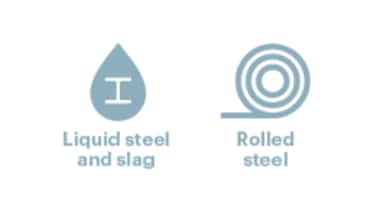What is iron ore?
Iron ores are rocks and minerals from which metallic iron can be extracted. There are four main types of iron ore deposit: massive hematite, which is the most commonly mined, magnetite, titanomagnetite, and pisolitic ironstone. These ores vary in colour from dark grey, through to deep purple, rusty red and bright yellow. Iron is responsible for the red colour in many of our rocks and the deep red sands of the Australian deserts.

Abundant element
Iron makes up close to 5% of the Earth's crust.

Steel
It takes around 1.6 tons of iron ore to produce one ton of steel.

Key ingredient
The world uses 20 times more iron (in the form of steel) than all other metals put together.

Big machines
Our iron ore trains are over 2.5km, or 264 ore cars long! It can take up to half an hour to walk from one end to the other.

Large-scale shipping
The ships we use to transport iron ore to our customers can carry around 47 Olympic-sized swimming pools worth of material.

Fe
The chemical symbol for iron is 'Fe'. This comes from its Latin name, Ferrum.
How is iron ore used?
98 per cent of all iron ore is converted into pig iron for steel making. It is then used in construction, transportation, energy infrastructure and even household appliances.
Construction
Household appliances
Transport
Energy infrastructure
How is steel made?

Mixing with coke
Iron ore is mixed with coke from super-heated metallurgical coal in a blast furnace.
.jpg?w=378&hash=7A4E6342C811064ECF1C727417A6D716)
Heating
Air that has been heated to around 1,200°C is injected into the furnace, converting the iron ore to molten pig iron and slag.

Removing impurities
Once impurities are removed, alloying elements are added. The steel is then cast, cooled and rolled, ready for use.
Where is iron ore found?
Iron ore deposits have been located all over the world, with Australia, Brazil, the United States and Canada being the largest producing countries. We have interests in iron ore assets in Australia and Brazil.

Western Australia
Our Western Australia Iron Ore (WAIO) business contains 5 mines in the Pilbara region.
With 5 mines, 4 processing hubs and 2 port facilities, our Pilbara iron ore business is all connected by more than 1,000 kilometres of rail infrastructure. At each mining hub ore from the mines is crushed, beneficiated (where necessary) and blended to create high-grade hematite lump and fines products.

Brazil
Samarco Mineracao S.A. (Samarco) is a non-operated joint venture iron ore operation.
BHP Billiton Brasil and Vale each hold a 50% shareholding in Samarco. Following the Fundão dam failure in 2015, operations at the iron ore operation have resumed without the need of tailings dams and with a new, safer filtration system. The autonomous Renova Foundation was established to remediate and compensate for the impacts of the dam failure.

Meet Aaron from Port Hedland
Aaron from Port Hedland drives the longest, heaviest, distributed power trains in the world. The iron ore he transports is used to produce steel and build cities.
How is iron ore mined?
From pit to port, our iron ore undergoes a series of processes before export.
- First, we explore the geology of the region to find the best iron ore prospects for our operations.
- Once the ideal site has been chosen, the ore is drilled and blasted.
- It is then transported to the primary crusher for processing.
- The crushed ore is sorted over screens and resized to different specifications, such as lump and fines products.
- Once the iron ore is processed, a stacker builds a stockpile in the stockyards.
- When ready for transportation, a reclaimer picks up the ore from the stockpiles and conveys it to train load out facilities.
- Trains transport the iron ore to ports.
- The iron ore is then loaded on to ships at our port facilities and exported to our customers around the world.
What is the future for iron ore?
As the world continues to require steel for key construction and infrastructure projects, we expect demand for iron ore to continue into the future. Our challenge is to continue producing this vital commodity in a way that supports decarbonisation efforts, and reduces the greenhouse gas emissions footprint of our productions. The ramp up of the US$3.6 billion South Flank iron ore mine in Western Australia is ahead of schedule and we have revised our medium-term production guidance to more than 300 Mtpa. We are assessing expansion alternatives to take us toward 330 Mtpa of production.

